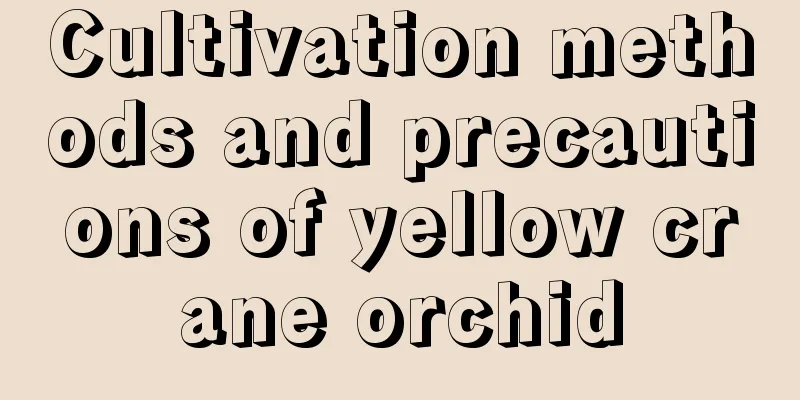Cultivation methods and precautions of yellow crane orchid

Soil managementPotted yellow crane orchid is suitable for relatively loose, fertile and well-drained soil, preferably fertile soil with a high humus content. You can use some leaf mold, garden soil, pond soil, etc. which contain a lot of nutrients. Make sure to keep the soil moderately moist to facilitate plant growth. Temperature ManagementThe temperature suitable for Yellow Crane Orchid is about 18-25℃. This flower is relatively cold-resistant, but the temperature in winter should be kept above 6℃ as much as possible. Lighting ManagementYellow crane orchid prefers a relatively warm and humid environment, and grows best in a semi-shaded space. Be careful to avoid direct sunlight. When the sun is strong in summer, appropriate shading should be carried out to avoid sunburning the leaves. Generally speaking, blocking about 50% of the light is sufficient. If conditions permit, you can plant the crane orchid directly under the shade of a tree or in a tall flower bush. Moisture ManagementThe crane orchid likes moisture and is not drought-tolerant. It needs more watering during its vigorous growth period, but water accumulation in the pot should be avoided. In summer, it is especially important to maintain the humidity of its growing environment. In addition to maintaining the moisture of the soil, you should also frequently sprinkle water around the flowers to increase the humidity of the surrounding air. After the peak flowering period, the crane orchid will begin to enter a short dormant period. At this time, the root function of the plant declines and the absorption capacity is greatly weakened, so it is necessary to control watering and reduce the amount of water. When the air is dry, spray water on the leaves frequently to keep them moist. Fertilizer managementDuring the growing period of the crane orchid, fertilizer should be mainly decomposed organic fertilizer, and light liquid fertilizer should be applied every two to three weeks. Before the flowering period arrives, fertilizer should be changed to phosphorus fertilizer and potassium fertilizer as the main fertilizer. After the flowering period, the remaining flowers should be cut off in time to reduce the loss of nutrients. Stop fertilizing after the temperature drops in autumn and winter. Pest controlCommon diseases and pests of crane orchid include white rot, anthracnose, scale insect pests, etc. These pest and disease problems are particularly likely to occur in the hot and humid environment in summer. Therefore, we must pay attention to prevention during daily maintenance. In addition to regular sterilization and pest control, it is more important to create an excellent environment suitable for plant growth, eliminate the main causes of diseases and pests, and eliminate diseases and pests fundamentally. |
<<: Cultivation methods and precautions of Xiaozhuya
>>: The difference between Gloxinia and Hibiscus
Recommend
Keep these 15 kinds of flowers at home to keep you cool and relieve the heat, and you don’t even need to turn on the air conditioner!
Blue Snowflake The name of blue snow flower gives...
Common diseases and pests of Calla Lily and their solutions
1. Diseases 1. Soft rot ①Symptoms: After getting ...
Coriander planting season and method steps How to plant coriander to make it sprout quickly
Coriander, also known as cilantro, is a food that...
How to plant petunia
Balcony potted plants management in four seasons ...
What are the cutting methods and time of sunflowers and what are the precautions for cutting?
Sunflowers can be propagated by cuttings , which ...
Difference between Poppy and Poppy
1. Difference of blades Thistle poppy has stem le...
Can the Dendrobium seedlings bloom in the same year? What should I do if they grow slowly?
1. Can it bloom in the same year? Dendrobium seed...
When should the spider plant be repotted?
1. Which month There are no restrictions on the t...
Cultivation methods and precautions of red cardinal coral
Farming methods Pot soil selection To cultivate c...
How to grow African jasmine in autumn
1. Watering It is still in the growing season in ...
How to grow broccoli
1. Soil Broccoli grows best in loose, breathable ...
Can summer black grapes be grown in the north?
Can summer black grapes be grown in the north? Su...
The efficacy and function of Dendrobium nobile
1. As a medicinal material Traditionally, this pl...
If you don’t water these 5 kinds of grass for a month, their value will increase 1,000 times after they grow into old trees!
Jade leaves old pile The Jade Plant belongs to th...
Christmas cactus amaryllis... blooms 3 or 4 times a year, how does it do that?
If you grow Christmas cactus like this, it can bl...









